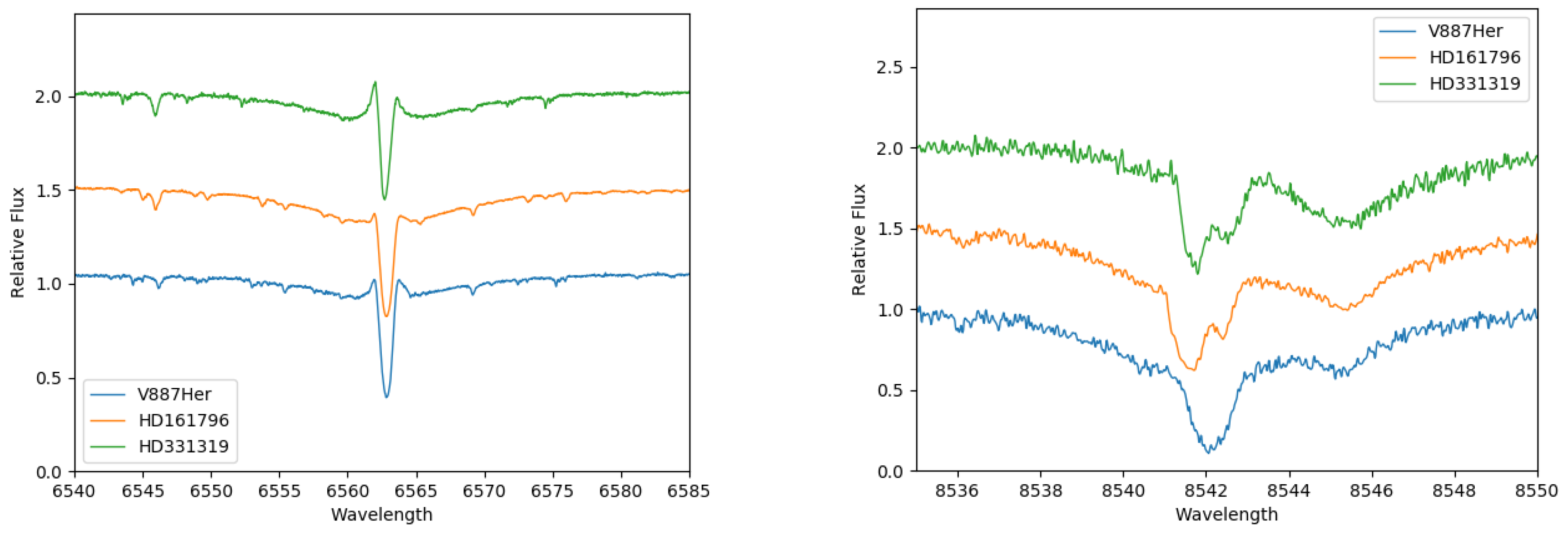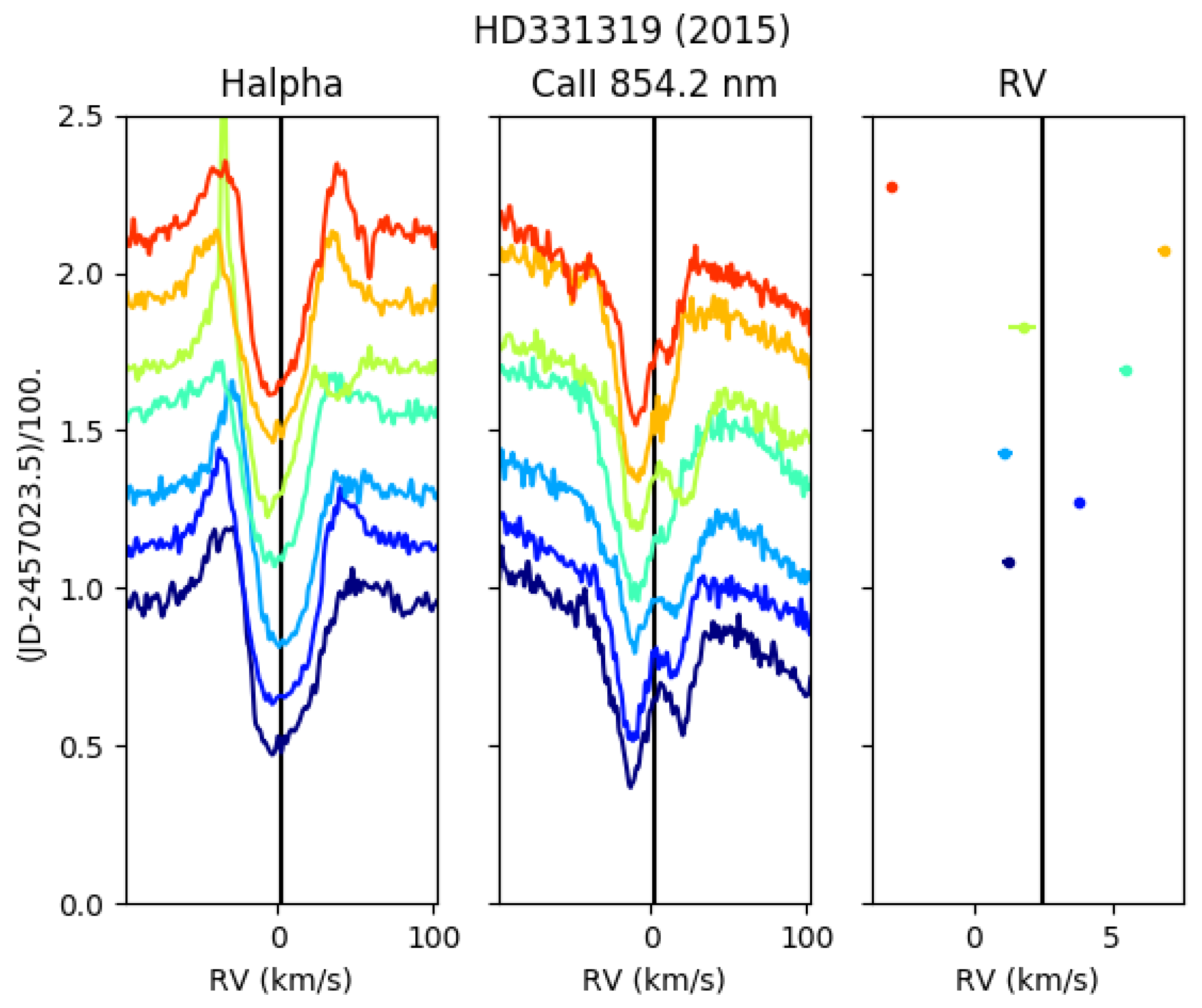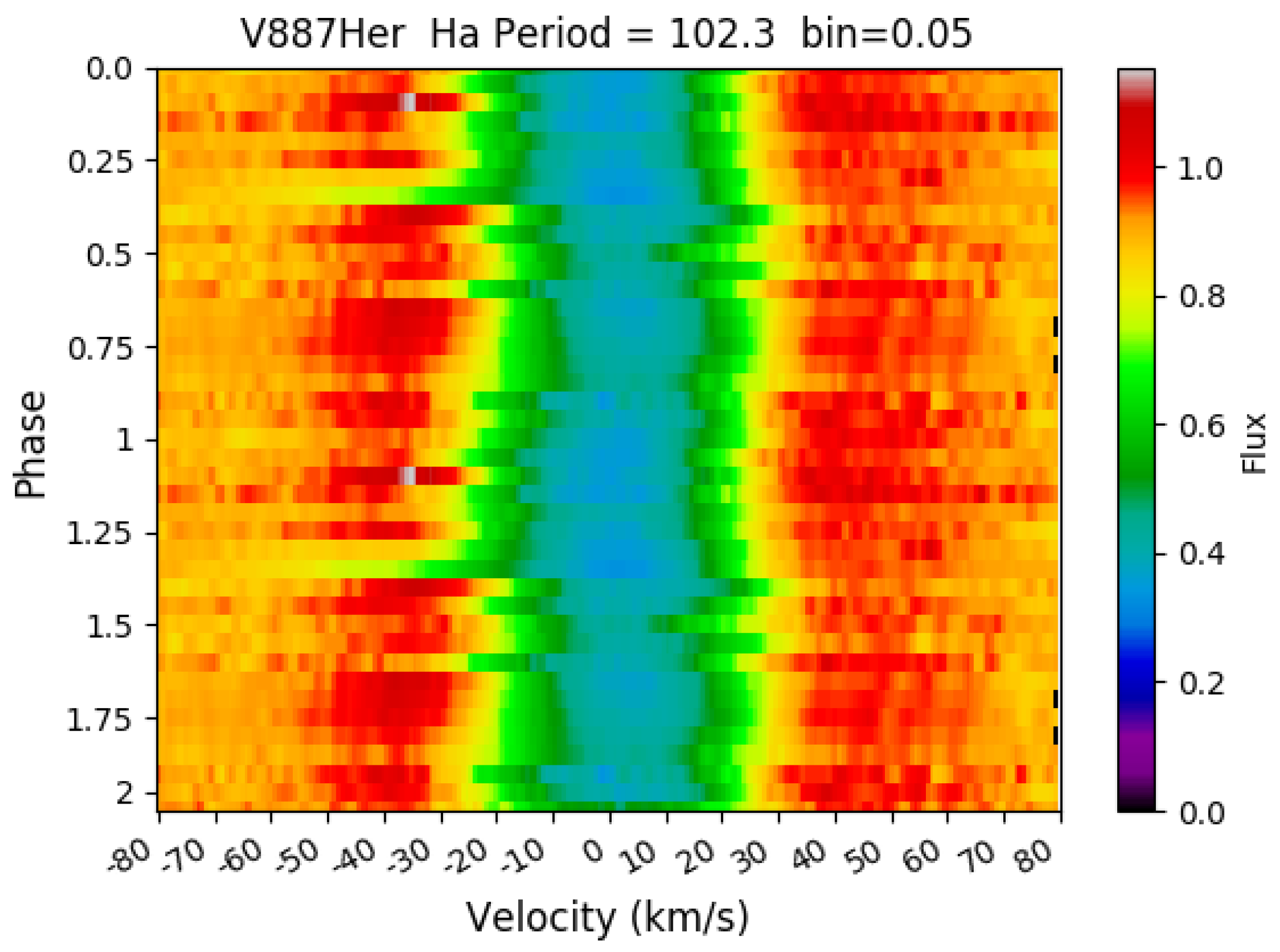Spectroscopic and Photometric Variability of Three Oxygen Rich Post-AGB “Shell” Objects
Abstract
1. Introduction
2. Observations and Analysis
3. Results and Discussion
3.1. Radial Velocity and Photometry
3.2. Spectroscopic Variability
Author Contributions
Funding
Acknowledgments
Conflicts of Interest
References
- Hrivnak, B.J.; Van de Steene, G.; Van Winckel, H.; Sperauskas, J.; Bohlender, D.; Lu, W. Where are the Binaries? Results of a Long-term Search for Radial Velocity Binaries in Proto-planetary Nebulae. Astrophys. J. 2017, 846, 96. [Google Scholar] [CrossRef]
- Manick, R.; Van Winckel, H.; Kamath, D.; Hillen, M.; Escorza, A. Establishing binarity amongst Galactic RV Tauri stars with a disc. Astron. Astrophys. 2017, 597, A129. [Google Scholar] [CrossRef]
- Van Winckel, H. Post-AGB binaries as tracers of stellar evolution. In Planetary Nebulae: Multi-Wavelength Probes of Stellar and Galactic Evolution; Liu, X., Stanghellini, L., Karakas, A., Eds.; IAU Symposium; International Astronomical Union: Paris, France, 2017; Volume 323, pp. 231–234. [Google Scholar] [CrossRef]
- Min, M.; Jeffers, S.V.; Canovas, H.; Rodenhuis, M.; Keller, C.U.; Waters, L.B.F.M. The color dependent morphology of the post-AGB star HD 161796. Astron. Astrophys. 2013, 554, A15. [Google Scholar] [CrossRef]
- Sahai, R.; Sánchez Contreras, C.; Morris, M.; Claussen, M. A Quadrupolar Preplanetary Nebula: IRAS 19475+3119. Astrophys. J. 2007, 658, 410–422. [Google Scholar] [CrossRef]
- Ueta, T.; Meixner, M.; Bobrowsky, M. A Hubble Space Telescope Snapshot Survey of Proto-Planetary Nebula Candidates: Two Types of Axisymmetric Reflection Nebulosities. Astrophys. J. 2000, 528, 861–884. [Google Scholar] [CrossRef]
- Lewis, B.M. On the Transience of Circumstellar Shells about |B|>=10deg OH/IR Stars. I. Basic Statistics. Astrophys. J. 2000, 533, 959–968. [Google Scholar] [CrossRef]
- Raskin, G.; van Winckel, H.; Hensberge, H.; Jorissen, A.; Lehmann, H.; Waelkens, C.; Avila, G.; de Cuyper, J.P.; Degroote, P.; Dubosson, R.; et al. HERMES: A high-resolution fibre-fed spectrograph for the Mercator telescope. Astron. Astrophys. 2011, 526, A69. [Google Scholar] [CrossRef]
- Van Winckel, H.; Jorissen, A.; Gorlova, N.; Dermine, T.; Exter, K.; Masseron, T.; Østensen, R.; Van Eck, S.; Van de Steene, G. Post-AGB binaries in an evolutionary perspective: A HERMES monitoring programme. Memorie della Societa Astronomica Italiana 2010, 81, 1022. [Google Scholar]
- Hrivnak, B.J.; Lu, W.; Nault, K.A. Variability in Proto-planetary Nebulae. IV. Light Curve Analysis of Four Oxygen-rich, F Spectral Type Objects. Astron. J. 2015, 149, 184. [Google Scholar] [CrossRef]
- Kochanek, C.S.; Shappee, B.J.; Stanek, K.Z.; Holoien, T.W.S.; Thompson, T.A.; Prieto, J.L.; Dong, S.; Shields, J.V.; Will, D.; Britt, C.; et al. The All-Sky Automated Survey for Supernovae (ASAS-SN) Light Curve Server v1.0. Publ. Astron. Soc. Pac. 2017, 129, 104502. [Google Scholar] [CrossRef]
- Hrivnak, B.J.; Van de Steene, G.; Van Winckel, H.; Lu, W.; Sperauskas, J. Variability in Proto-Planetary Nebulae: V. Velocity and Light Curve Analyses of IRAS 17436+5003, 18095+2704, and 19475+3119. ArXiv, 2018; arXiv:1810.13037. [Google Scholar]
- Hrivnak, B.J.; Lu, W.; Sperauskas, J.; Van Winckel, H.; Bohlender, D.; Začs, L. Studies of Variability in Proto-planetary Nebulae. II. Light and Velocity Curve Analyses of IRAS 22272+5435 and 22223+4327. Astrophys. J. 2013, 766, 116. [Google Scholar] [CrossRef]
- Fokin, A.B.; Lèbre, A.; Le Coroller, H.; Gillet, D. Non-linear radiative models of post-AGB stars: Application to HD 56126. Astron. Astrophys. 2001, 378, 546–555. [Google Scholar] [CrossRef]
- Klochkova, V.G. Circumstellar envelope manifestations in the optical spectra of evolved stars. Astrophys. Bull. 2014, 69, 279–295. [Google Scholar] [CrossRef]
- Začs, L.; Musaev, F.; Kaminsky, B.; Pavlenko, Y.; Grankina, A.; Sperauskas, J.; Hrivnak, B.J. Spectroscopic Variability of IRAS 22272+5435. Astrophys. J. 2016, 816, 3. [Google Scholar] [CrossRef]
- Bollen, D.; Van Winckel, H.; Kamath, D. Jet creation in post-AGB binaries: the circum-companion accretion disk around BD+46 442. Astron. Astrophys. 2017, 607, A60. [Google Scholar] [CrossRef]



© 2018 by the authors. Licensee MDPI, Basel, Switzerland. This article is an open access article distributed under the terms and conditions of the Creative Commons Attribution (CC BY) license (http://creativecommons.org/licenses/by/4.0/).
Share and Cite
Steene, G.C.V.d.; Hrivnak, B.J.; Winckel, H.V.; Sperauskas, J.; Bohlender, D. Spectroscopic and Photometric Variability of Three Oxygen Rich Post-AGB “Shell” Objects. Galaxies 2018, 6, 131. https://doi.org/10.3390/galaxies6040131
Steene GCVd, Hrivnak BJ, Winckel HV, Sperauskas J, Bohlender D. Spectroscopic and Photometric Variability of Three Oxygen Rich Post-AGB “Shell” Objects. Galaxies. 2018; 6(4):131. https://doi.org/10.3390/galaxies6040131
Chicago/Turabian StyleSteene, Griet C. Van de, Bruce J. Hrivnak, Hans Van Winckel, Julius Sperauskas, and David Bohlender. 2018. "Spectroscopic and Photometric Variability of Three Oxygen Rich Post-AGB “Shell” Objects" Galaxies 6, no. 4: 131. https://doi.org/10.3390/galaxies6040131
APA StyleSteene, G. C. V. d., Hrivnak, B. J., Winckel, H. V., Sperauskas, J., & Bohlender, D. (2018). Spectroscopic and Photometric Variability of Three Oxygen Rich Post-AGB “Shell” Objects. Galaxies, 6(4), 131. https://doi.org/10.3390/galaxies6040131




